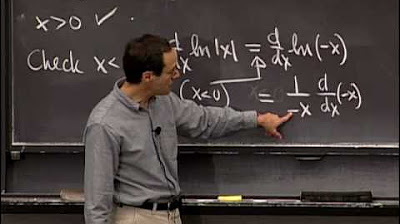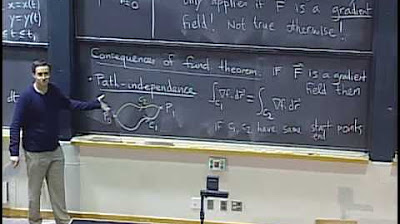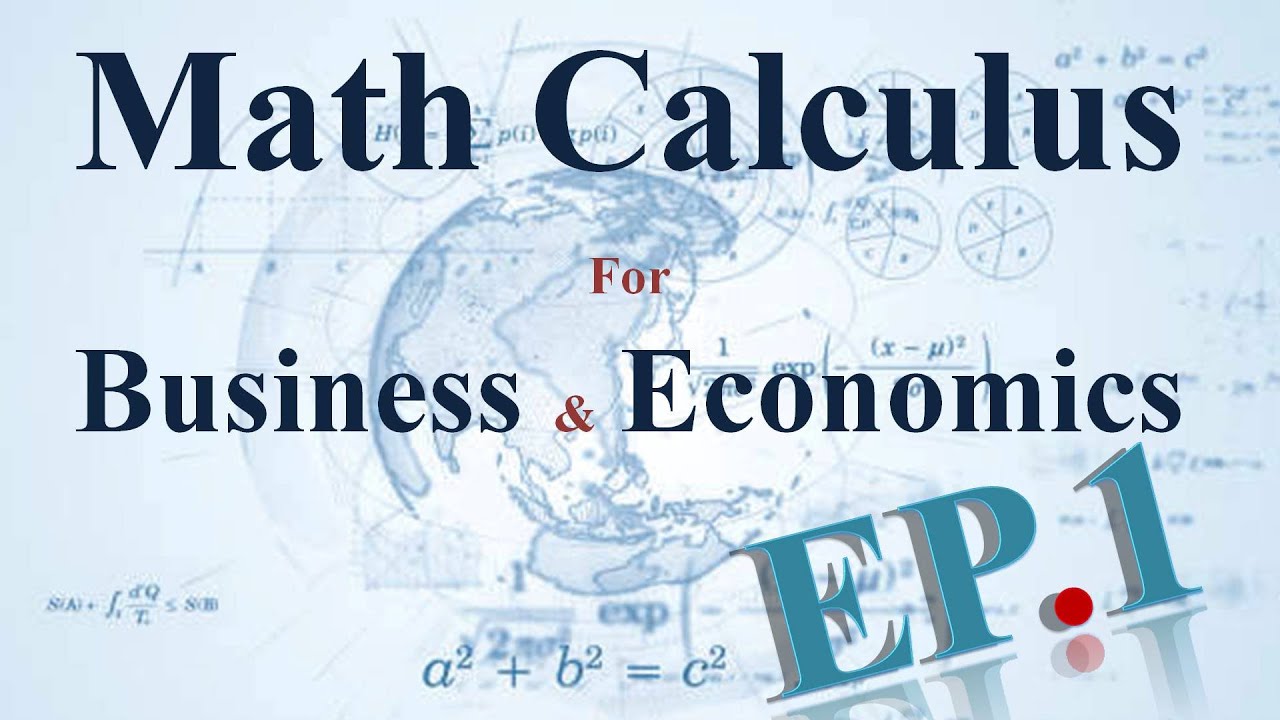Unit II: Lec 2 | MIT Calculus Revisited: Single Variable Calculus
TLDRThis MIT OpenCourseWare lecture delves into the concept of infinitesimals and their role in calculus. The professor introduces infinitesimals through approximations, using the example of distance-rate-time problems and the tangent line to a curve. He illustrates the approximation of the cube of 4.01 and explains the error involved in using the tangent line as a proxy for the curve. The lecture emphasizes the mathematical language of differentials, defining 'dy' and 'dx' to allow 'dy/dx' to be treated as a quotient, setting the stage for understanding derivatives and integrals.
Takeaways
- 📚 The lecture introduces the concept of infinitesimals in calculus, which are quantities that approach zero faster than their respective variables.
- 🔍 The discussion starts with a common problem in algebra: calculating distance when the rate is not constant, which leads to the development of calculus concepts.
- 📈 The geometric interpretation of 'delta y' is the change in 'y' along a curve with respect to 'x', and the tangent line provides an approximation for this change.
- 📝 The tangent line's slope at a point 'x1' is represented by 'dy/dx' evaluated at 'x1', and it's used to calculate 'delta y-tan', the change in 'y' along the tangent line.
- 🧩 The approximation error when using 'delta y-tan' to estimate 'delta y' is analyzed, showing that as 'delta x' gets smaller, the error diminishes rapidly.
- 📉 The script uses a specific example of cubing the number 4.01 to illustrate the approximation process and the resulting error.
- 📚 The binomial theorem is applied to expand '(x1 + delta x) cubed', highlighting the relationship between 'delta y' and 'delta y-tan'.
- 🔑 The error term 'k delta x' is defined, where 'k' approaches zero as 'delta x' approaches zero, emphasizing the rapid decrease of the error term.
- 📈 The limit concept is used to show that 'k' times 'delta x' is an infinitesimal, and its significance in calculus is explained.
- 📝 The lecture introduces the notation 'dy/dx' and explains its meaning as the derivative of 'y' with respect to 'x', not as a division of 'dy' by 'dx'.
- 📐 The concept of differentials is foreshadowed as a crucial element in both differential and integral calculus, with a promise of deeper exploration in future lectures.
Q & A
What is the main topic of the lecture?
-The main topic of the lecture is the concept of infinitesimals and approximations in calculus, specifically in relation to the tangent line approximation of a curve.
Why is the concept of infinitesimals important in calculus?
-The concept of infinitesimals is important in calculus because it helps in understanding the behavior of functions near a point, especially when dealing with limits and derivatives, and it provides a foundation for differential calculus.
What is the relationship between 'delta y' and the tangent line?
-'Delta y' geometrically represents the change in 'y' along the curve with respect to 'x'. The tangent line approximation, 'delta y-tan', is a simpler computation based on the slope of the tangent line at a given point, and it serves as an approximation to the true 'delta y'.
How does the lecture connect the concept of infinitesimals to distance, rate, and time problems?
-The lecture connects infinitesimals to distance, rate, and time problems by discussing the constant rate assumption in such problems and how the concept of a tangent line can be used to approximate changes in distance when the rate is not constant.
What is the significance of the tangent line's slope in the context of this lecture?
-The slope of the tangent line is significant because it represents the derivative of the function at a specific point, which is used to compute the change in 'y' along the tangent line ('delta y-tan') and serves as a basis for approximation.
Can you explain the 'error term' mentioned in the lecture?
-The 'error term' in the lecture refers to the difference between the actual change in 'y' ('delta y') and the change in 'y' along the tangent line ('delta y-tan'). It is represented by 'k delta x', where 'k' is a variable that approaches 0 as 'delta x' approaches 0.
What is the role of the limit in the discussion of infinitesimals?
-The limit is used to describe the behavior of the error term as 'delta x' approaches 0. It helps in understanding how the error term becomes infinitesimally small, which is crucial for the concept of infinitesimals.
How does the lecture use the example of cubing 4.01 to illustrate the approximation?
-The lecture uses the example of cubing 4.01 to show how one can approximate the value by using the tangent line at a point near 4.01 (in this case, at x=4). It demonstrates the process of calculating 'delta y-tan' and comparing it to the actual change in 'y'.
What is the purpose of defining 'dy' and 'dx' in the context of differentials?
-The purpose of defining 'dy' and 'dx' is to allow the notation 'dy/dx' to be treated as a fraction, which simplifies calculations and understanding in differential calculus. 'dy' is defined as 'delta y-tan', and 'dx' as 'delta x'.
How does the lecture address the issue of 0/0 indeterminate forms in calculus?
-The lecture addresses the 0/0 indeterminate form by emphasizing that when both the numerator and denominator approach 0, the result is not necessarily 0. Instead, it depends on the behavior of the function and its derivative, as illustrated by the limit of 'k' approaching 0.
What is the final takeaway message from the lecture regarding approximations and infinitesimals?
-The final takeaway message is that while approximations can be useful, the key insight is understanding that the error in the approximation goes to 0 much faster than 'delta x' itself, which is the essence of infinitesimals. This understanding is crucial for grasping the concepts of derivatives and differentials.
Outlines
📚 Introduction to Infinitesimals and Approximations
The script begins with an introduction to the concept of infinitesimals, a fundamental idea in calculus, and discusses the importance of approximations. It sets the stage for the lecture by referencing a common problem in algebra involving distance, rate, and time, and how calculus extends this concept. The professor emphasizes the need to understand the rate of change when it's not constant, which is where infinitesimals come into play. A geometric interpretation of the tangent line and its slope as a derivative is introduced, highlighting the difference between 'delta y' (change in y along the curve) and 'delta y-tan' (change along the tangent line).
📈 The Tangent Line as an Approximation
This paragraph delves deeper into the approximation of 'delta y' using the tangent line. It uses the specific example of cubing the number 4.01 and compares the actual value to the value obtained by approximating along the tangent line at x=4. The professor illustrates how the tangent line serves as a good approximation near the point of tangency and explains the mathematical process behind this approximation, including the calculation of the derivative and its role in estimating 'delta y-tan'.
🔍 Exploring the Error in Approximation
The script continues by examining the error involved in using the tangent line as an approximation for the curve. It discusses the binomial theorem and how it can be used to expand and understand the difference between 'delta y' and 'delta y-tan'. The concept of an infinitesimal is introduced, explaining that the error term 'k delta x' is an infinitesimal because it approaches zero faster than 'delta x' as 'delta x' gets smaller.
📘 Mathematical Formulation of Approximation Error
This section presents a more abstract and mathematical discussion of the approximation error. It introduces the idea of taking the limit of the difference between the slope of the tangent line and the average change of 'y' with respect to 'x' along the curve, and how this leads to the definition of an infinitesimal. The professor emphasizes the importance of understanding the rate at which the error term approaches zero.
📌 The Role of Infinitesimals in Calculus
The script explains the profound significance of infinitesimals in calculus, particularly in the context of the 0/0 indeterminate form. It discusses how the error term 'k delta x', being an infinitesimal, allows for the simplification of expressions involving derivatives when taking limits. The professor uses the example of differentiating a composite function to illustrate how the error term drops out, leaving a clean expression for the derivative.
📐 Differentials and the Language of Infinitesimals
This paragraph introduces the concept of differentials, 'dy' and 'dx', as a way to formalize the language of infinitesimals. The professor explains the notation 'dy/dx' and how it can be thought of as a fraction, with 'dy' representing the change in 'y' along the tangent line and 'dx' representing the change in 'x'. The script also humorously touches on the idea of canceling common factors in fractions and the importance of not misapplying this concept in calculus.
📝 Conclusion and Preview of Future Topics
The final paragraph wraps up the lecture by summarizing the key points discussed about infinitesimals and approximations. It emphasizes the importance of understanding the underlying concepts rather than just the approximations themselves. The professor also previews the next lecture, which will delve into the derivative of composite functions and the role of differentials in calculus. The script concludes with acknowledgment of funding and a call to support MIT OpenCourseWare.
Mindmap
Keywords
💡Infinitesimals
💡Approximations
💡Derivative
💡Tangent Line
💡Rate of Change
💡Slope
💡Error Term
💡Limit
💡Binomial Theorem
💡Differentials
Highlights
Introduction to the concept of infinitesimals in calculus, a fundamental yet elusive concept.
Relating infinitesimals to familiar topics like distance, rate, and time problems from elementary algebra.
Exploring the implications of non-constant rates in distance equals rate times time problems.
Geometric interpretation of 'delta y' as the change in 'y' along the curve with respect to 'x'.
The tangent line's role in approximating the curve and its significance in calculus.
The difference between 'delta y' and 'delta y-tan', and the concept of approximation.
Using the derivative to compute 'delta y-tan', which is not an approximation but an exact value.
The intuitive understanding that as 'delta x' gets small, the difference between 'delta y' and 'delta y-tan' also diminishes.
A specific example of cubing 4.01 to illustrate the approximation method.
The importance of understanding the error in the approximation and its relationship to 'delta x'.
Generalizing the approximation method to any curve 'y' equals 'x cubed' and its derivative.
The binomial theorem's application in expanding '(x1 + delta x) cubed' to find 'delta y'.
The error term 'k delta x' and its behavior as 'delta x' approaches 0.
The mathematical definition of an infinitesimal and its properties.
The significance of the error term 'k delta x' approaching 0 faster than 'delta x' itself.
The concept of differentials and their role in both differential and integral calculus.
Defining 'dy' and 'dx' separately to allow 'dy/dx' to be treated as a fraction.
The importance of understanding the language of differentials for future lectures on derivatives of composite functions.
The final recipe summarizing the relationship between 'delta y', 'dy/dx', and 'delta x', including the infinitesimal term.
The analytical language's ability to convey the same results without geometric intuition.
Transcripts
Browse More Related Video

Lec 15 | MIT 18.01 Single Variable Calculus, Fall 2007

How to Explain Calculus to a 6th Grader?

Math 11 - Section 1.5

Lec 20: Path independence and conservative fields | MIT 18.02 Multivariable Calculus, Fall 2007

Math Calculus for Business and Economics - Related Rates wrt time Episode. 1 LIVE MATH

Math 11 - Sections 1.3-1.4
5.0 / 5 (0 votes)
Thanks for rating: